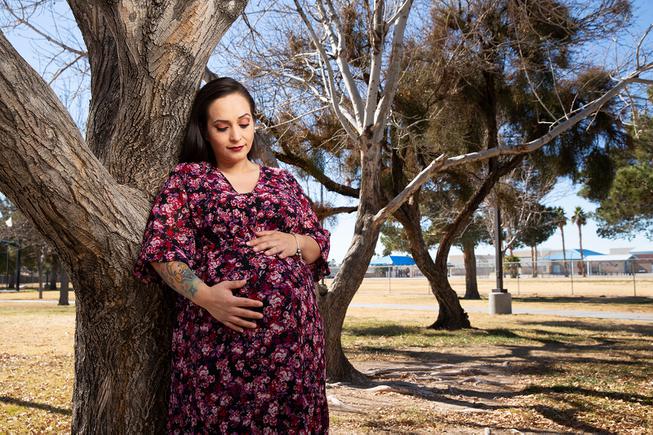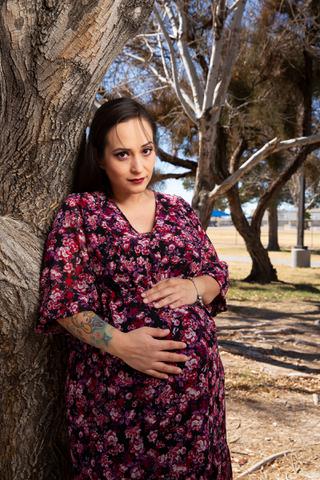
Erika Marquez, 34-year-old DACA recipient, poses for a portrait in a local park Tuesday Feb. 8, 2022. At 34 weeks into her pregnancy, she and her family worry about the high cost of medical expenses while not being able to qualify for Medicaid.
Sunday, Feb. 27, 2022 | 2 a.m.
Erika Marquez is 35 weeks pregnant with her third child, a daughter who will be delivered by cesarean section next month.
But the joys of preparing to welcome her child are often replaced with worries about how to pay for it all. As an independent sales contractor, Marquez, an immigrant living in Las Vegas on Deferred Action for Childhood Arrivals (DACA) status, does not have health insurance. She also doesn’t qualify for federal Medicaid — like the approximately 14,000 other Dreamers and even more undocumented immigrants in Nevada — to cover the $700 epidural she requires for theC-section, she said.
The prenatal, delivery and postnatal care for her two former children were covered through health insurance from her previous job and her husband’s employer. But even with the combined coverage, their bills reached approximately $10,000 out of pocket — the impetus for the couple to file for bankruptcy.
“Pregnancy is not always beauty and belly rubs,” Marquez said. “Sometimes pregnancies are very painful, very frustrating.”
Health care options for undocumented immigrants like Marquez are limited in Nevada, where costly hurdles are often an inescapable burden. In other cases, undocumented immigrants avoid health care services entirely because of how expensive they can be — a risk to their health and mental well-being, local undocumented immigrants said.
In Nevada, only immigrants with permanent resident status can access Medicaid — and then five years after obtaining their green card. This change came in September last year with the expiration of the 2019 Public Charge Rule, a Trump-era policy that made it easier for immigration officials to deny legal status or United States entry to immigrants that relied on government assistance.
But the change did not affect Marquez and other undocumented immigrants, who in 2018 comprised 19%, or 587,686 people, of Nevada’s population, according to the American Immigration Council. There were 297,865 women, 267,865 men and 21,956 children in Nevada without legal status, with one in six Nevadans born to at least one immigrant parent.
DACA recipients in Nevada only qualify for insurance if it is provided through their employer. Emergency Medicaid grants coverage to those who do not typically qualify for Medicaid because of their immigration status, and it pays for the health care costs of the medical emergency.
For her current pregnancy, Marquez proceeded without prenatal care, she said, wishing to avoid the high costs even as she experiences discomfort closer to her due date. Emergency Medicaid will help with the cost of her delivery but not the epidural for her C-section, she said.
She said she recalled paying about $1,000 for her second child’s first three months of prenatal care in 2021. To circumvent further expensive treatment back then, Marquez halted care for the second and third trimesters, she said.
When she is not pregnant and needs care, Marquez said she would use underground sources like a botanica, a Mexican physician who provides medical services but is not a certified doctor.
“I would go to the doctor only if I was literally dying,” Marquez said. “I kind of have literally been on edge since the moment that I found out I was pregnant. … It’s a difficult and stressful pathway to be able to have children here in the state of Nevada without any sort of help.”
Uninsured Nevadans, undocumented or not, make up a substantial share of the state’s population at 14%, or 397,974 people. That’s 3.5 percentage points above the national average of 10.5%, according to a 2019 study from the Guinn Center. It is the sixth-highest uninsured rate in the country, and large swaths of the uninsured population reside in Clark County, the study also says.
Raymundo, an undocumented and uninsured Las Vegan who preferred to go by his first name for safety reasons, said he seeks medical care when it is “an absolute emergency.” When he was sick with COVID-19, he, like Marquez, sought under-the-table treatment, paying for a clandestine doctor in cash.
“Everything is so expensive,” he said via text in Spanish. “You honestly can’t even afford to get sick for any reason.”
When emergencies do strike, hospitals like the University Medical Center treat patients first and work out a payment schedule later, if the person’s treatment is not covered by Emergency Medicaid. UMC does not monitor the immigration status of its patients, it said in a statement to the Sun.
“We offer personalized assistance to every patient who visits UMC for emergency services, helping them find payor sources whenever possible,” UMC told the Sun. “If there are no coverage options available, they are billed accordingly as self-pay patients.”
A moving problem
Audrey Peral, lead organizer at the nonprofit Make the Road Nevada, gave birth to her son in California. She was 18 years old, living in Nevada undocumented and afraid of the high cost of giving birth in the state.
So Peral moved in with her family in California, where she said her costs were lower than they would have been back home. She delivered her son and returned, nine months later, to Las Vegas.
“I moved back to California very specifically to get that access to prenatal care to ensure the livelihood of my son,” she said. “I know firsthand how difficult it really is, when you’re sick, when you’re ailing. You can’t go to the doctor because it’s so incredibly expensive, and you’re expected to pay completely out of pocket for any kind of medical care.”
That was 14 years ago.
Peral has since attained her permanent resident status after being a DACA recipient for years. She has watched other Las Vegas mothers migrate to California, either temporarily for delivery or permanently for better coverage.
“We’re putting American citizens at risk because these babies are, you know, … American citizens,” she said. “It’s really sad to see the little bit of progress that Nevada has made over the years. There really hasn’t been much progress at all.”
A change for undocumented Californians came in 2020, when the state expanded Medi-Cal — its public health insurance program that grants coverage to low-income Californians — to undocumented immigrants 26 and under.
This spring, an additional 700,000 people over age 50 will also become eligible for the program, and a new proposal from California Gov. Gavin Newsom would grant the missing group, aged 26 to 49, access to the state insurance. The new policy would take effect in January 2024 and cost approximately $2.2 billion per year, Newsom said when revealing the state’s budget in January.
“I’m proud to be here,” he said at a news briefing at the time. “I hope we see this replicated across the country.”
In Nevada, it’s not as clear cut.
Margarita Salas Crespo, senior adviser in the Governor’s Office of New Americans, said the biggest barrier to expanding insurance to undocumented residents was funding. The money would need to come from the state, she explained, and would not be matched federally. She did not provide an estimate of the cost for Nevada annually.
“We’re looking at, what are our options to make affordable health care more accessible to all?” Crespo said. “That is definitely going to be something that the Governor’s Office for New Americans is going to be looking at, as well as, how do we ensure that our undocumented communities also have some form of access to health care? And it’s a possibility, but at this moment, we just don’t know because funding is the number one barrier.”
The Guinn Center study references Medi-Cal at the end of its report, the most recent of its kind and based on data from 2017. It says that although states like California have found “pioneering solutions for their uninsured populations” — back then, California had just expanded Medi-Cal to 19- to 25- years-old undocumented residents — Nevada’s lack of state income tax would make dollars for a Medi-Cal equivalent “difficult to secure.”
The study additionally discovered that among Nevada’s 2017 unauthorized population of 210,000, 94,500 undocumented immigrants in Nevada lacked health insurance.
Areli, an undocumented immigrant in Las Vegas who preferred to go by her first name for safety, said living without health insurance was “very difficult and stressful.” She only seeks medical care for necessary services, like a pap smear or in an emergency. Like Raymundo, Areli pays for these services in cash.
While she has considered moving to another state, like California, for better health care access, Areli remains hopeful for a change in her home state, she said.
“I would have decent medical care and in turn better health,” she said via text in Spanish. “We can’t do physical check-ups and be able to prevent a chronic illness.”
Providing support
Connecting local immigrants with free health resources, like COVID-19 vaccination pop-ups or dental clinics at local high schools, is essential to supporting the undocumented community, said Itzel Hernandez, health equity organizer at Make the Road Nevada. Hernandez said her work typically comprised door-to-door and phone call outreach.
For other groups, policy changes, like pushing for Nevada’s version of the Medi-Cal expansion, would make an impact for immigrants, said Laura Martin, executive director of the Progressive Leadership Alliance of Nevada (PLAN).
“I would hope the community would be more receptive to funding health care for their neighbors and their co-workers and their classmates as our Legislature was receptive to spending money on a stadium,” she said.
Crespo said that if any change were to happen in Nevada, it would first need to happen on a federal level.
“It’s more of a waiting-if-anything-will-happen,” she said. “We’re definitely looking to participate in those conversations and also just discuss, what does that look like for the undocumented community and the immigrant community at large?”

